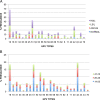A cross sectional study of HPV type prevalence according to age and cytology
- PMID: 23363541
- PMCID: PMC3575232
- DOI: 10.1186/1471-2334-13-53
A cross sectional study of HPV type prevalence according to age and cytology
Abstract
Background: A cross sectional study to investigate HPV prevalence according to age and cytology.
Methods: Women presenting to a gynaecological outpatient clinic for a Pap smear test were included in the study (n=3177). All women had cervical cytology and HPV testing.
Results: Overall prevalence of any 24 HPV type analysed was 33.1% (95% CI 31.5% to 34.7%) and HPV 16 and HPV 42 were the most frequent (6.7% (95% CI 5.8% to 7.6%), 6.8% (95% CI 5.9% to 7.6%)), in total samples. Multiple HPV infection rate was 12.9% (95% CI 11.8% to 14.1%). High risk HPV (hrHPV) types were present in 27.4% (95% CI 25.8% to 28.9%) of the samples.HPV prevalence was highest among 14 to 19 y.o (46.6% (95% CI 40.7%-52.4%)) and second highest among 30-34 y.o. (39.7%, 95% CI 35.4%-44%). HPV 16 was highest among 20-24 (9.0% (95% CI 6.4%-11.6%)) and second highest among 50 to 54 y.o. (6.3% (95% CI 2.9% to 9.8%).In Low-grade Squamous Intraepithelial Lesions (LgSIL) cytology samples, the most frequently detected hrHPV types were: 16 (14.5% (95% CI 12.1% to 16.9%)), 51 (13.0% (95% CI 10.7% to 15.3%)) and 53 (9.1% (95% CI 7.2% to 11.1%)) and in High-grade Squamous Intraepithelial Lesions (HgSIL) were: HPV 16 (37.2% (95% CI 26.5% to 47.9%)), HPV 51 (17.9% (95% CI 9.4% to 26.5%)) and HPV 18 (12.8% (95% CI 5.4% to 20.2%)).
Conclusions: In the population studied, HPV 16 and 51 were the most frequent detected hrHPV types. HPV positivity, hrHPV and multiple HPV types infections were higher in young women, while HPV prevalence declined with increasing age and presented two peaks a higher (14-19 y.o.) and a lower one (30-34 y.o.) These results may contribute to the creation of a national screening programme.
Figures
Similar articles
-
Pre-vaccination prevalence of infections with 25 non-high-risk human papillomavirus types among 1,000 Slovenian women in cervical cancer screening.J Med Virol. 2014 Oct;86(10):1772-9. doi: 10.1002/jmv.23997. Epub 2014 Jun 30. J Med Virol. 2014. PMID: 24978445
-
Spectrum of genital human papillomavirus infection in a female adolescent population.Sex Transm Dis. 1995 Jul-Aug;22(4):236-43. doi: 10.1097/00007435-199507000-00007. Sex Transm Dis. 1995. PMID: 7482107
-
Interest of cytology combined with Xpert® HPV and Anyplex® II HPV28 Detection human papillomavirus (HPV) typing: differential profiles of anal and cervical HPV lesions in HIV-infected patients on antiretroviral therapy.HIV Med. 2018 Nov;19(10):698-707. doi: 10.1111/hiv.12661. Epub 2018 Jul 30. HIV Med. 2018. PMID: 30062761
-
Prevalence of high-risk HPV types and abnormal cervical cytology in American Indian/Alaska Native women, 2003-2005.Public Health Rep. 2011 May-Jun;126(3):330-7. doi: 10.1177/003335491112600305. Public Health Rep. 2011. PMID: 21553660 Free PMC article.
-
Detection and genotyping of cervical HPV with simultaneous cervical cytology in Turkish women: a hospital-based study.Arch Gynecol Obstet. 2012 Jul;286(1):203-8. doi: 10.1007/s00404-012-2280-z. Epub 2012 Mar 7. Arch Gynecol Obstet. 2012. PMID: 22395863 Review.
Cited by
-
Knowledge, beliefs and communication preferences with regards to the HPV vaccine; the perspective of unvaccinated Greek adolescent girls, young women, and mothers of vaccine-eligible girls.Health Psychol Behav Med. 2018 Aug 2;6(1):180-202. doi: 10.1080/21642850.2018.1505518. Health Psychol Behav Med. 2018. PMID: 34040827 Free PMC article.
-
Screening for persistent high-risk HPV infections may be a valuable screening method for young women; A retrospective cohort study.PLoS One. 2018 Oct 24;13(10):e0206219. doi: 10.1371/journal.pone.0206219. eCollection 2018. PLoS One. 2018. PMID: 30356297 Free PMC article.
-
High risk human papillomavirus prevalence and genotype distribution among women infected with HIV in Manaus, Amazonas.Virol J. 2018 Feb 17;15(1):36. doi: 10.1186/s12985-018-0942-6. Virol J. 2018. PMID: 29454382 Free PMC article.
-
Human papillomavirus infection by anatomical site among Greek men and women: a systematic review.Eur J Cancer Prev. 2016 Nov;25(6):558-71. doi: 10.1097/CEJ.0000000000000207. Eur J Cancer Prev. 2016. PMID: 26628088 Free PMC article.
-
Infection with human cytomegalovirus, Epstein-Barr virus, and high-risk types 16 and 18 of human papillomavirus in EGFR-mutated lung adenocarcinoma.Croat Med J. 2023 Apr 30;64(2):84-92. doi: 10.3325/cmj.2023.64.84. Croat Med J. 2023. PMID: 37131310 Free PMC article.
References
-
- de Sanjose S, Quint WG, Alemany L, Geraets DT, Klaustermeier JE, Lloveras B, Tous S, Felix A, Bravo LE, Shin HR, Vallejos CS, de Ruiz PA, Lima MA, Guimera N, Clavero O, Alejo M, Llombart-Bosch A, Cheng-Yang C, Tatti SA, Kasamatsu E, Iljazovic E, Odida M, Prado R, Seoud M, Grce M, Usubutun A, Jain A, Suarez GA, Lombardi LE, Banjo A. et al.Human papillomavirus genotype attribution in invasive cervical cancer: a retrospective cross-sectional worldwide study. Lancet Oncol. 2010;11(11):1048–1056. doi: 10.1016/S1470-2045(10)70230-8. - DOI - PubMed
-
- Clifford GM, Rana RK, Franceschi S, Smith JS, Gough G, Pimenta JM. Human papillomavirus genotype distribution in low-grade cervical lesions: comparison by geographic region and with cervical cancer. Cancer Epidemiol Biomarkers Prev. 2005;14(5):1157–1164. doi: 10.1158/1055-9965.EPI-04-0812. - DOI - PubMed
-
- Smith JS, Melendy A, Rana RK, Pimenta JM. Age-specific prevalence of infection with human papillomavirus in females: a global review. J Adolesc Health. 2008;43(4 Suppl):5–25. S25.e1-41. - PubMed
-
- Muñoz N, Bosch FX, de Sanjose S, Herrero R, Castellsagué X, Shah KV, Snijders PJ, Meijer CJ. International Agency for Research on Cancer Multicenter Cervical Cancer Study Group. Epidemiologic classification of human papillomavirus types associated with cervical cancer. N Engl J Med. 2003;348(6):518–527. doi: 10.1056/NEJMoa021641. - DOI - PubMed
Publication types
MeSH terms
LinkOut - more resources
Full Text Sources
Other Literature Sources
Medical
Research Materials




